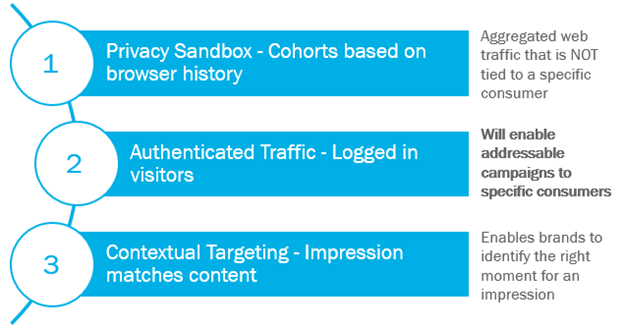This transcript from our webinar, Playbook to Prepare for the End of Cookies, provides a great overview of how marketers should prepare for the end of third-party cookies.
With Todd Dziedzic, SVP of Digital & Analytics of Porch Group Media.
Host: Cookies, as you know, are going away. But there really is a lot of effort and activity and choices being made every day about how to plug that gap.
All of this effort and money is being spent by really big, sophisticated companies, but there are also smaller companies creating solutions to tell the whole story.
So, this is the beginning of a discussion or another chapter in the discussion. We’ll continue to explore as things evolve, and, in fact, we at Porch Group Media are working on solutions that hopefully will put our own clients in good position to not just manage risk here as cookies go away, but to really benefit.
In terms of what the outcome is going to be, it’s a big change, it’s going to be very disruptive, but ultimately, we think that this is a good thing for marketers that’ll open the door to a lot more precision, and a lot better customer experiences.
So to take us through the story is Todd Dziedzic who leads digital and analytics for Porch Group Media. He and his team are both creating products and solutions and engaging with the digital ecosystem to put Porch Group Media and our clients in the best position.
Todd Dziedzic: Thanks, I’m excited to discuss this topic. I’ll be discussing how the system works and what’s changing about it.
How Third-Party Cookies Work

This slide shows what happens when you log onto the internet. You go to a website and some independent server, which may or may not be the site that you’re visiting, will drop a cookie on your machine.
Then, the next time you fire up your browser, that cookie is able to track where you go.
So when you go to a website, brands can say, here’s Todd – who wants to put an impression in front of him? And any brand who thinks Todd’s a good fit will put their bids in and that and revenue will help support that website.
What happens in the background is this third party is tracking where I visit, and I may or may not know what’s being tracked by those companies.
Browsers and Cookies
If we go through the history, we see these three browsers – Safari, Firefox, and Chrome.

The big one is Chrome – they first made the announcement that they will shut down cookies about a year and a half ago and they extended the deadline to the end of 2023.
But when they make the change, it will be disruptive because they’re such a large share of US web traffic, and it’s only growing.
It’ll make it very difficult for advertisers to continue to do what they’re doing when Chrome shuts down cookies.
Three Options to Replace the Cookies
So what’s going to replace that ecosystem when cookies end?
There are three prevailing options or technologies.

Privacy Sandbox:
The first one is the one Chrome wants people to adopt. It’s called the Privacy Sandbox.
Their thought is that there’s value for advertisers in knowing the sequence of websites that these users went to because that tells a lot about who that user is. And you can then infer a really highly engaged prospect audience based on this.
But there’s problems with this – one of them is the specificity of it.
The thinking behind the privacy sandbox is that a segmentation of cohorts will be released based on the websites that consumers visited.
Brands can then say, oh, this is a middle-aged man, who’s interested in sports versus a millennial mom.
However, there are limitations on the data that is available to make that segmentation based on what the user leaves in their browser history. Consumers are savvy enough about browsers to know that they can click on a button and see their browser history and the specific websites that they browse. If they went somewhere that they don’t want people to know about, they can just delete it.
So that’s one solution that is not operational yet. That may be one of the reasons the deadline was extended to 2023 so Chrome could double-down on what they’re doing. There are lots of questions and lots of issues yet to be resolved with these cohorts.
Authenticated Traffic
The second option is logged-in traffic or authenticated traffic so it’s based on only a portion of web visitors. You may have a user who will register and log-in, but others who won’t.
But when consumers freely choose to log-in and provide their identity, there’s a system developing where we can use those consumer identities and attach insights to this authenticated traffic solution.
Contextual Targeting
This is a sort of hybrid of the other two solutions. It’s really about the moment the impression is being served and not so about much categorizing or cataloging and warehousing the click stream. But it’s the publishers noting what the click sequence is, or the view sequence of that current browser to the point where they can say, here’s the sort of experience this user is seeking out.
Then brands can look at their campaigns and determine if this kind of context makes sense for the campaign they’re trying to drive.
All of these solutions will prevail in some form and it’s up to brands to figure out what kinds of campaigns would work across each of these technologies.
The one we think that has a ton of promise is actually available now for testing and is this authenticated traffic. That’s the one we want you to focus on when we think about the playbook. Think about this kind of option and how that fits into your acquisition portfolio.
Focus on Authenticated Traffic to be Ready
To get ready for the end of cookies, we suggest three things:

Invest in First Party Data
Investing in first party data is about finding that single source of prospects with these persistent linking elements such as name, address, email and phone number.
Porch Group Media provides data elements to define consumers along those persistent identity linking elements. Brands need to source BOTH the consumer identify elements AND the descriptive data needed to personalize their ads. Securing the identity elements (especially email address) is key to a future proof addressable strategy.

Consumer IDs
Consumer IDs is about using data elements to link a prospect audience to a consumer ID and finding them in the digital ecosystem.

Match Results
Match results is about looking at various attributes that help you find a responsive prospect. This involves using analytics, profiling consumers and then mapping to the data that is available on the prospect. You may have to combine a few things together to get a segment that works.
This can be scaled up based on what is working well to start activating consumer IDs against the prospect universe that had been identified and developing a scalable universe.
Porch Group Media Sales Dashboard is designed to attribute sales to addressable campaigns After activity using consumer IDs, match the sales from the campaign time frame back to the audience to determine Return On Ad Spend.

Authenticated Traffic will elevate the addressability of programmatic display to the level of email or walled garden accuracy. Brands will need to optimize the response across channel versus the cost of that channel.

Interested in learning how Porch Group Media can help you prepare for the end of cookies? Complete this form for additional information.





